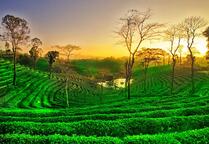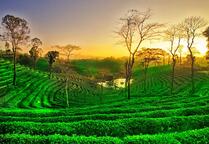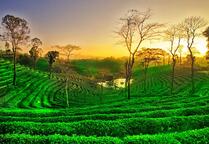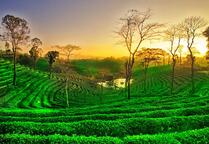Holidays - Seven Sisters
[1] Arunachal Pradesh
There are 26 major tribes and a number of sub tribes living in the state. Most of these communities are ethnically similar but their geographical isolation from each other has brought amongst them certain distinctive characteristics in language, dress and customs. Broadly, the people may be divided into three cultural groups on the basis of their socio religious affinities.The Monpas and Sherdukpens of Tawang and West Kameng district follow the lamaistic traditions of Mahayana Buddhism. Culturally similar to them are Membas and Khambas who live in the high mountains of the northern borders. Khamtis and Singphos inhabiting the eastern part of the State are Buddhist of Hinayan Sect. The second group of people are Adis, Akas, Apatanis, Bungnis, Nishis, Mishimis, Mijis, Thangsos etc. who worship the Sun and the Moon namely Donyi Polo and Abotani. Their religious rituals largely coincide with the phases or agricultural cycles. Arunachal finds mention in the literature of Kalika Purana and Mahabharata. This place is supposed to be the Prabhu Mountains of the Puranas. It was here that the sage Parashuram washed away his sins, sage Vyasa meditated, king Bhismaka founded his kingdom and lord Krishna married his consort Rukmini.
[2] Assam
Assam is a state of breath taking scenic beauty, rarest flora and fauna, lofty green hills, vast rolling plain, mighty waterways and a land of fairs and festivals.The ancient name of Assam was Pragjyotishpur. However, during the time of the Ahom conquest, Pragjyotishpur was known as Kamrup. In ancient Sanskrit literature, both the names Pragjyotishpur and Kamrup were used as a designation for ancient Assam. In 1228, the Ahoms, Shan tribe from North Thailand entered and defeated the Kamrup ruler and established a kingdom, which came to be known as Assam with its capital at Sivasagar (Sibsagar). Most probably, the modern name Assam comes from Ahoms, the dynasty that ruled from the 13th to early 19th Century. The ancient name Kamrup, is today confined to only a district of Assam.The population of Assam as per the 2001 Census (Provisional) is 26638407. Summer months are from April to October and the winter months are from November to March.
[3] Manipur
Manipur shares 352 km common International boundary with Myanmar and lies south of Nagaland, north of Mizoram and east of Assam. It covers an area of 22,327 sq. km with a population of 23,88,634(Provisional census 2001). Manipur is a mosaic of traditions and cultural patterns. The wet forests, the temperate forest and the pine forests occur between 900-2700 metres above sea level and they together sustain a host of rare and endemic plant and animal life. There are around 500 varieties of orchids which grow in Manipur of which 472 have so far been identified. Hoolock gibbon, Slow loris, Clouded leopard, Mrs. Hume's Barebacked pheasant, Blyth's Tragopan, Hornbills etc. form only a part of the natural heritage of Manipur. However, the most unique is the "Sangai", the dancing deer. The floating mass of vegetation on the Loktak Lake sustains small herds of this endemic deer which is the most threatened species in the world.
[4] Meghalaya
Meghalaya is inhabited by three tribal groups namely the Khasis, the Jaintias and the Garos. The Khasis reside in the centre of the State, the Jaintias in the east and Garos in the west. Khasis, Jaintias, Bhois, Wars collectively known as the Hynniewtrep people are of Austro Monkhmer race and Garos who prefer to call themselves as Achiks are of the Tibeto-Burman race. All the three tribes follow the matrilineal system of society where the lineage and ancestral property pass down from mother to daughter. According to scholars, the Hynniewtrep(seven huts)people are known to be the earliest settlers in the undivided state of Assam and one of the earliest ethnic group of settlers in the Indian sub-continent.
[5] Mizoram
Mizoram is located in the northeastern part of India. It is bound by Assam and Manipur in the north, Myanmar in the east and south and Tripura and Bangladesh in the west. The Tropic of Cancer passes through the middle of Mizoram and therefore the climate of this area is neither very cold in winter nor very hot in summer.The average winter temperature ranges between 11 and 21 degree Celsius.The summer temperature ranges between 20 and 30 degree Celsius.The State has thick bamboo forests and boasts of a number of streams and rivers. Wild animals found in the State are barking deer, blyths, tragopan, stump tailed macaque, swamp deer, tiger, leopard, elephants, hoolock gibbon, sambar, wild boar, wild cats, hornbill, pheasant etc. Over 300 varieties of butterflies in different colours can also be seen in the state. "Mizo" in local language means a highlander. The Christians make up a solid 84% of the Mizo population while 7% are Hindus and 1% Muslims. Mizos are very fond of music, singing and dancing. Among many other festivals, Chapchar Kut, a three-day spring festival celebrated during the month of March is the most popular festival. In this festival, people young and old, men and women dressed in their colourful costumes and headgears perform various folk dances to the tune of drums, gongs and cymbals. Mim Kut celebrated during August-September and Powl Kut during December are harvest festivals and also involve singing and dancing.
[6] Nagaland
Nagaland is bound by Arunachal Pradesh and parts of Assam in the North; Manipur in the South; Myanmar (Burma) on the East and Assam in the West. 16 major tribes along with other sub-tribes inhabit the State. Each of the sixteen odd tribes and sub-tribes have their own languages, customs and traditions and they can easily be distinguished by their colourful dresses, ornaments and beads that they wear. The traditional ceremonial attire of each tribe is very colourful and attractive. Nagaland is blessed with a salubrious climate throughout the year. The temperature from June to September is between 16 to 31 deg Celsius and from October to February it is between 4 & 24 degree Celsius.The main rivers of the state are the Dhansiri, Doyang, Dikhu, Milak, Zungki and Tizu and the highest peak is Saramati, which are approximately 3841 metres above sea level. The land, flora, fauna, the people and their warm hospitality all combine to make Nagaland and ideal destinations for the tourists.
[7] Tripura
Tripura formerly known as Hill Tippera is located in the extreme Southwest corner of the Northeastern Region. It is bound on the North, Southeast and Southwest by Bangaladesh and in the East by Assam and Mizoram. A former princely state, Tripura is the second most populous state in the region with a population density of 262 per sq. km. As per the provisional census of 2001, the population of the state is 31,91,168. A large section of the population are Bengalis besides nineteen tribes who are residing in the hills of the state. Tripuri people form the biggest tribe comprising 60 percent of the total tribal population. Each tribe has their own festivals and a number of dances, which are performed during festival times.

Best of Assam
Best of Assam
8 Days
I am Interested
Best of Nagaland
Best of Nagaland
5 Days
I am Interested
Best of Seven-Sister States ... The Unexplored India !
1 night Guwahati [Assam] + 2 nights Shillong [Meghalaya] + 2 nights Kaziranga [Assam] + 2 nights Kohima [Ngaland]
Type: Adventure Tours, Children Oriented, Cultural Trips, Exotic Destinations, Hill Destinations, Historical Destinations, Leisure Destinations, Religious & Pilgrimage Tours, Wildlife Tours

8 Days
I am Interested
Meghalaya - Scotland of the East
Meghalaya - Scotland of the East
5 Days
I am Interested















